Module 3 - Benjamin-Mills
Module 3 - Benjamin-Mills
Module 3 - Benjamin-Mills
You also want an ePaper? Increase the reach of your titles
YUMPU automatically turns print PDFs into web optimized ePapers that Google loves.
LIFE REVEALS ITS TWISTED SECRET<br />
EP2.8<br />
Pauling’s 3-helix model (1952/1953)<br />
We have formulated a structure for the nucleic acids which is compatible<br />
with the main features of the X-ray diagram and with the general<br />
principles of molecular structure, and which accounts satisfactorily for<br />
some of the chemical properties of the substances. The structure involves<br />
three intertwined helical polynucleotide chains. Each chain, which is<br />
formed by phosphate di-ester groups and linking b-D-ribofuranose<br />
[D-ribose] or b-D-deoxyribofuranose [D-deoxyribose] residues with 3', 5'<br />
linkages, has approximately twenty-four nucleotide residues in seven turns<br />
of the helix. The helixes have the sense of a right handed screw. The<br />
phosphate groups are closely packed about the axis of the molecule, with<br />
the pentose residues surrounding them, and the purine and pyrimidine<br />
groups projecting radially, their planes being approximately perpendicular<br />
to the molecular axis. The operation that converts one residue to the next<br />
residue in the polynucleotide chain is rotation by about 105° and<br />
translation by 3.4 Å.<br />
A detailed description of the structure is appearing in the February<br />
1953 issue of the Proceedings of the National Academy of Sciences of the<br />
United States of America.<br />
Watson’s response to Pauling’s ideas (1953)<br />
At once I felt something was not right. I could not pinpoint the mistake,<br />
however, until I looked at the illustrations for several minutes. Then I<br />
realized that the phosphate groups in Linus’ model were not ionized, but<br />
that each group contained a bound hydrogen atom and so had no net<br />
charge. Pauling’s nucleic acid in a sense was not an acid at all. Moreover,<br />
the uncharged phosphate groups were not incidental features. The<br />
hydrogens were part of the hydrogen bonds that held together the three<br />
intertwined chains. Without the hydrogen atoms, the chains would<br />
immediately fly apart and the structure vanish.<br />
Everything I knew about nucleic-acid chemistry indicated that<br />
phosphate groups never contained bound hydrogen atoms.<br />
Pauling’s later comments<br />
I calculated the number of polynucleotide chains per unit to be exactly<br />
three. This result surprised me, because I had expected the value 2 if the<br />
nucleic acid fibres really represented genes … During the next month I<br />
strove to find a way of arranging the polynucleotide chains in a triple<br />
helix, and was successful, although the structure was described as “an<br />
extraordinarily tight one, with little opportunity for change in positions of<br />
the atoms” …<br />
In hindsight, it is evident that I made a mistake … in having decided to<br />
study the triple helix rather than the double helix. … I am now astonished<br />
that I began work on the triple helix structure, rather than on the double<br />
helix. I had not forgotten … that the gene might consist of two<br />
complementary molecules, but for some reason, not clear to me now, the<br />
triple chain structure apparently appealed to me, possibly because the<br />
assumption of a three-fold axis simplified the search for an acceptable<br />
structure.<br />
Crick and Watson’s crucial paper<br />
They acknowledge the contribution of Rosalind Franklin and Maurice Wilkins at<br />
the end of the paper. (See next sheet.)<br />
Linus Pauling, Robert B. Corey 1953.<br />
Structure of the Nucleic Acids. In Nature,<br />
February 21, vol. 171, p.346.<br />
James D. Watson 1968. The Double Helix<br />
(London: Weidenfeld & Nicolson, p. 160).<br />
With new introduction, 1999 (London:<br />
Penguin Books).<br />
Linus Pauling 1974. Molecular Basis of<br />
Biological Specificity. In Nature, vol. 248,<br />
p. 771.<br />
„ Salters Advanced Chemistry 2000 – see Copyright restrictions<br />
185



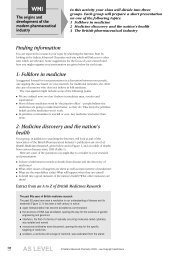
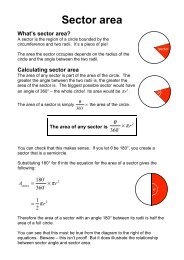
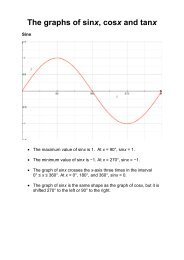
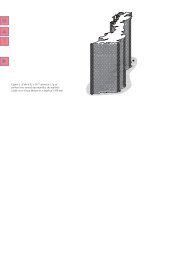

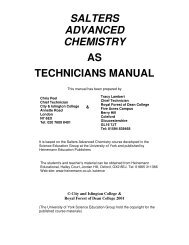



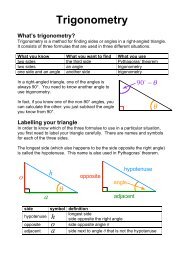
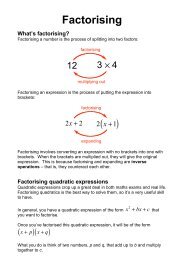
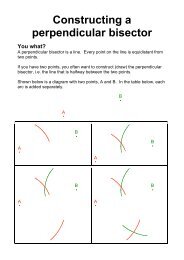

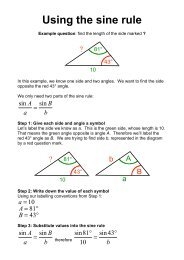
![ISI Web of Knowledge [v.4.10] - All Databases Results - Benjamin-Mills](https://img.yumpu.com/39253071/1/184x260/isi-web-of-knowledge-v410-all-databases-results-benjamin-mills.jpg?quality=85)